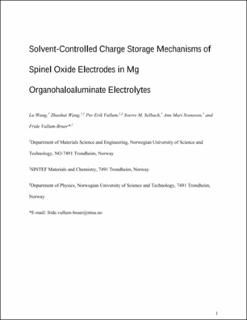Solvent-Controlled Charge Storage Mechanisms of Spinel Oxide Electrodes in Mg Organohaloaluminate Electrolytes
Wang, Lu; Wang, Zhaohui; Vullum, Per Erik; Selbach, Sverre Magnus; Svensson, Ann Mari; Vullum-Bruer, Fride
Peer reviewed, Journal article
Accepted version

Permanent lenke
https://hdl.handle.net/11250/2720586Utgivelsesdato
2017Metadata
Vis full innførselSamlinger
- Publikasjoner fra CRIStin - SINTEF AS [5802]
- SINTEF Industri [1566]
Originalversjon
10.1021/acs.nanolett.7b03978Sammendrag
Considering the improved safety, reduced cost, and high volumetric energy density associated with Mg batteries, this technology has distinct advantages for large-scale energy storage compared to other existing battery technologies. However, the divalency of the Mg2+ cation cause sluggish magnesiation kinetics in crystalline host materials, resulting in poor performance with regards to capacity and cycling stability for intercalation based electrodes. Here, we present a Mg battery using Mn3O4 as the electrode material and Mg metal as the counter electrode in a Mg organohaloaluminate electrolyte. The reversible capacity when Mn3O4 was used as cathode reached ∼580 mAh g–1 at a current density of 15.4 mA g–1, whereas a reversible capacity of ∼1800 mAh g–1 was obtained in an anode configuration. The Mn3O4 in a cathode configuration shows excellent cycling stability with no loss of capacity after 500 cycles at a current density of 770 mA g–1. As an anode, Mn3O4 retained 86% of its initial capacity after 200 cycles. These exceptional charge storage properties and high cycling stability are attributed to highly reversible interfacial reactions involving the electrolyte solvents. Our conclusions are supported by density functional theory calculations in addition to quantitative kinetics analysis and scanning transmission electron microscopy combined with energy dispersive spectroscopy and electron energy loss spectroscopy.